Archived Water Damage Blog Posts
Cincinnati Heavy Rains
7/5/2024 (Permalink)
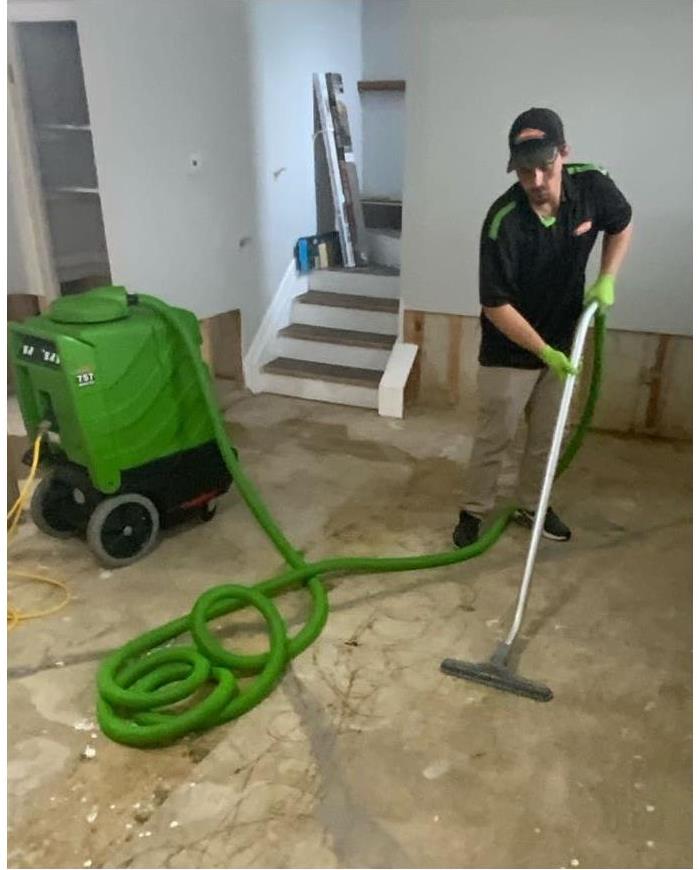 Norwood Floods
Norwood Floods
Recently Greater Cincinnati has seen a significant amount of rain fall leading to flash flooding as well as water intrusions. Many of the homes across both Butler and Hamilton Counties have basements. A good number of these basements have either sump pumps or floor drains to help remove unwanted water that has found its way into what once was a dry space. We at SERVPRO recommend checking the operation of your sump pump on a regular basis for proper functionality. Experts also suggest keeping floor drains free of debris and flowing as designed. These few steps could save you from costly repairs. The following picture of the home in Norwood is an example of work that may be required to keep your property in a safe, sanitary and healthy state.
Things You Should Know About Water Damage
11/2/2022 (Permalink)
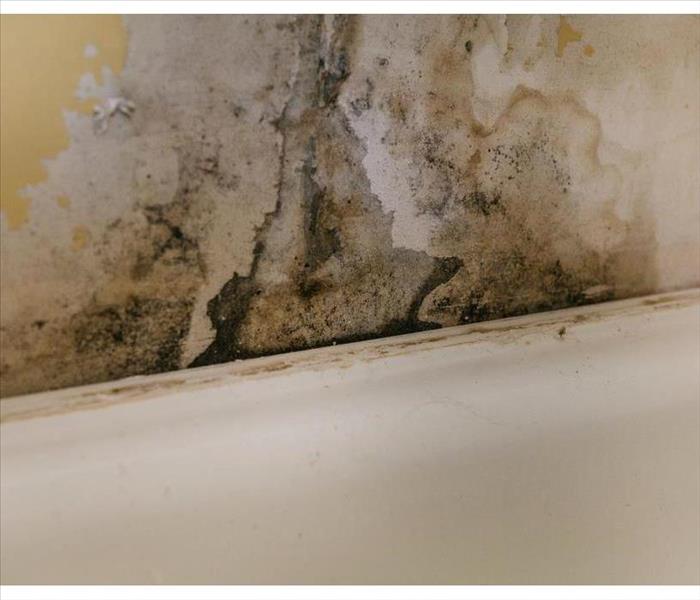 When water seeps into your home it can quickly cause mold to grow.
When water seeps into your home it can quickly cause mold to grow.
Everything You Need to Know About Water Damage
Water damage is not always easily visible. It often starts with a tiny leak in the roof or a pipe that bursts. This can lead to water getting under your home’s foundation, which can cause major structural damage. When water seeps into your home it can quickly cause mold and other expensive repairs. The best way to protect your investment is to call SERVPRO of East Central Cincinnati as soon as possible.
Your Plumbing System
The plumbing system of your home is a complex network of pipes, valves and fixtures. The pipes themselves are usually made from copper or steel. They're buried in the ground to prevent freezing and breakage; if one does break, it can cause significant damage to your home by way of flooding or mold growth. Even though most water lines today are made from plastic, rubber or other materials that reduce these risks, you should still be familiar with where they're located so that you can avoid damaging them yourself when working on projects around your property.
When Damage Is Discovered
Here are some steps to take when you suspect that your home has experienced water damage:
- Turn off all power sources and unplug all electronics that might have gotten wet. This includes TV sets, computers, and other devices with electrical components as well as any appliances that may have been damaged by water (such as refrigerators).
- Remove any items from your home that may be affected by high levels of moisture (such as carpets or wood floors) until they've been cleaned or dried out properly.
- Open windows and doors for ventilation if possible; this will help dry out damp areas quicker than simply leaving them alone without air circulation.
- Check all circuit breakers in case one flipped during flooding events; if so then reset them before turning anything back on again!
Water Damage Cleanup Technique
The first step in cleaning up water damage is to stop the spread of the water. It's easier said than done; once the water has seeped into your walls, it's tough to keep it from going further.
The best way to stop the spread of moisture is by using a fan(s) with high-powered output and directing them at where you want the airflow directed. The idea here is that if we direct enough air at one area, we'll be able to dry out that spot faster than if we leave it alone—but don't overdo it! Too much airflow could cause additional problems by blowing off insulation in your walls or knocking down some ceiling tiles.
Now that we've stopped any further damage from occurring (hopefully), let's talk about what tools you should use for cleanup purposes:
The Science of Drying
One thing that you should know about water damage is that it can be a long process. This isn’t necessarily a bad thing, though; in fact, it actually works to your advantage when you hire the right restoration company.
Your local restoration contractor will start by conducting an extensive inspection of your property to determine its overall condition and any potential risks involved with drying out. Once they have assessed the situation and determined what needs to be done, they can begin removing excess water through extraction methods like pumps or vacuums (or both). In addition to these methods of removing water from your home's structure, professional contractors may also use special drying equipment such as dehumidifiers or air movers. These devices allow them to more precisely control how much moisture remains in the air while simultaneously speeding up the process of extracting water from walls and floors throughout your house so that it doesn't continue damaging any other areas as well as helping prevent mold growth later on down there!
However long this process takes depends on many factors: how much damage has been done? How quickly did someone notice something was wrong? Was there too much standing water for long enough periods at certain spots? For example: if one room had two feet-high standing waves for two days straight before anyone noticed then chances are good there may still be some residual moisture left over so don't expect miracles overnight even if everything seems dry now.
Insurance Coverages
It's important to know that homeowners insurance generally covers water damage caused by a leaking pipe, appliance, or toilet overflow. If your home is damaged in this way, you should contact your insurer immediately. The company will send out a water restoration company to assess the damage and provide you with an estimate of what it will cost to make repairs. If you agree with their assessment, they'll move forward with making needed repairs—and then invoice your insurance company for reimbursement.
The reason this process works so well is because most homeowners policies have special exclusions for intentional acts (like someone breaking into your home) or natural disasters like fire and windstorms.
Why Pipes Break
There are many reasons why water damage occurs. The pipes in your home are made of materials that can corrode, so they can experience pinholes that may not be visible. Water can also get into the walls of your home when there is a leak outside or if it is too close to an edge of a wall. Water damage can occur from a variety of sources including dishwashers, washing machines, toilets, and showers: all appliances that use water will cause moisture build-up over time unless they are regularly cleaned out and maintained properly by an expert plumber.
A Professional Can Help
Now that you know about the proper steps to take in order to get it back into shape, you don't have to face this problem alone. SERVPRO of East Central Cincinnati is here for all your water damage needs!
SERVPRO is a professional cleaning company that specializes in restoring homes and businesses after they've experienced any type of disasters such as fire or flood damage. The highly trained technicians at SERVPRO will make sure that every last piece of debris is removed from your home so no trace remains after they're done working on it—that way there's no need for worry or concern when it comes time for resale value. You can rest assured knowing our experts will handle everything!
Important Steps You Should Take if Your Basement Floods
8/30/2022 (Permalink)
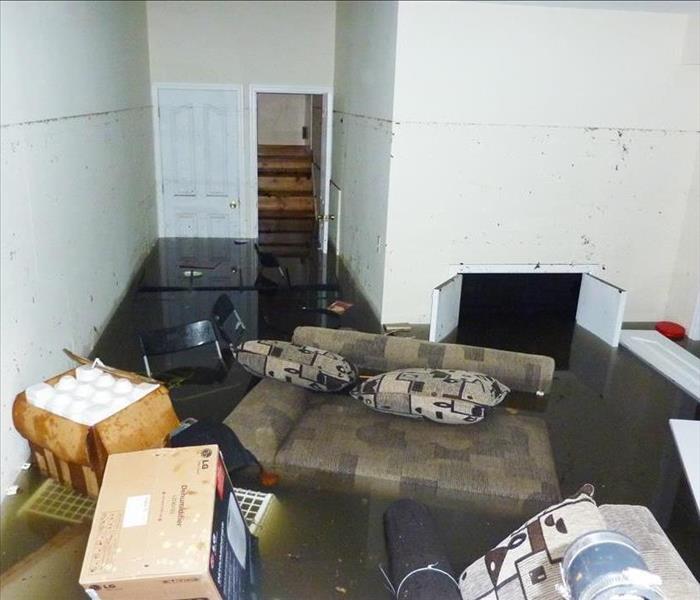 Flooded basement in Terrace Park, OH.
Flooded basement in Terrace Park, OH.
Wise homeowners do everything possible to keep their homes safe from disasters such as flooding. However, there may be times when, despite your best efforts, water still finds its way into your basement. There are many causes of house floods, but there are also some effective ways you can get rid of water once it infiltrates your Terrace Park, OH, property.
How can a Flood Occur in Your Home?
No one wants to think about a basement flood. Unfortunately, this is a harsh reality for many people. Flooding can happen in a number of different ways.
- Broken sump pump in the basement
- Poor drainage around the house, including insufficient rain gutters
- Pipe leak, pipe break or other plumbing issues
- Heavy rain
Get Someone on the Job
A flood in your house calls for immediate action. As soon as you notice water getting into your home, contact a professional restoration company without delay. When you enlist the help of an experienced team, you can have peace of mind and confidence that these experts will bring the right skills and equipment to not only get rid of the water but clean up in a timely and effective manner.
Remove the Water
The pros will start by removing the water from your home. They will use extraction machines to suck up standing water from your floor. During this process, it’s also important to speak to a qualified professional about pipe repair or about fixing any issues that caused the flooding.
Tear-Out
A team will also tear out carpet, hardwood, drywall or other materials that you can no longer use. This may also include furniture and personal items.
Clean-Up
The pros will also use heavy-duty cleaning agents to sanitize the affected area. This will help reduce the risk of mold growth.
If you’ve had flooding in your home, call a qualified professional right away. The faster you do this, the faster you’ll be safe and sound at home.
How To Deal With Frozen Pipes
3/21/2022 (Permalink)
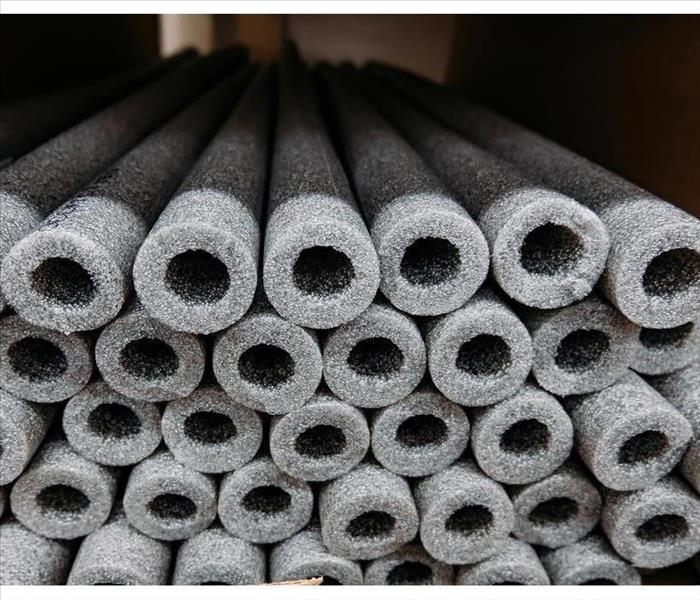 Insulate pipes that are particularly vulnerable.
Insulate pipes that are particularly vulnerable.
Prevent Frozen Pipes In Your Home
Winter weather can cause a lot of damage to your home. Prepping for winter means making sure there are no weak areas in your roof, around your windows, or in your foundation to let cold air or water in. Other hazards to look out for are frozen pipes. While the best protection is prevention, there are things you can do to salvage pipes before they wreak havoc on your home.
Locating Problems
A pipe freeze will often show up as a faucet that produces little to no water flow. If that happens, start by inspecting pipes in the following areas:
- Near exterior walls
- In the attic or basement
- In crawlspaces
If there is frozen water in a pipe, it may have already expanded enough to crack. If that is the case, turn off the water main and call a plumber. Warming the pipe up before it's fixed may result in water damage that can only be resolved by water restoration specialists.
Unfreezing Pipes
Sometimes, frozen pipes won't show any signs of stress or breakage. When this happens, you can fix the problem by simply warming the pipe. Keeping faucets open to keep warm water moving through the pipes can accomplish this goal. You can also use a hair dryer to warm up pipes or if the pipe is metal, a heat gun. Directing warm air from your HVAC unit into the walls can also unfreeze the water in the pipes.
Preventing Freezes
To prevent a pipe freeze, you want to make sure the pipes and the air around them stay warm. Insulate pipes that are particularly vulnerable. Keep the heater on in your home, and circulate the air so that it reaches the pipes. Opening cabinets and closet doors can help facilitate this circulation.
Frozen pipes can cause damage to your home in Amberley Village, OH, but dealing with this issue is fairly simple. By warming pipes and keeping them that way, you can prevent a lot of water damage.
How To Limit the Impact of the Spring Thaw
3/16/2022 (Permalink)
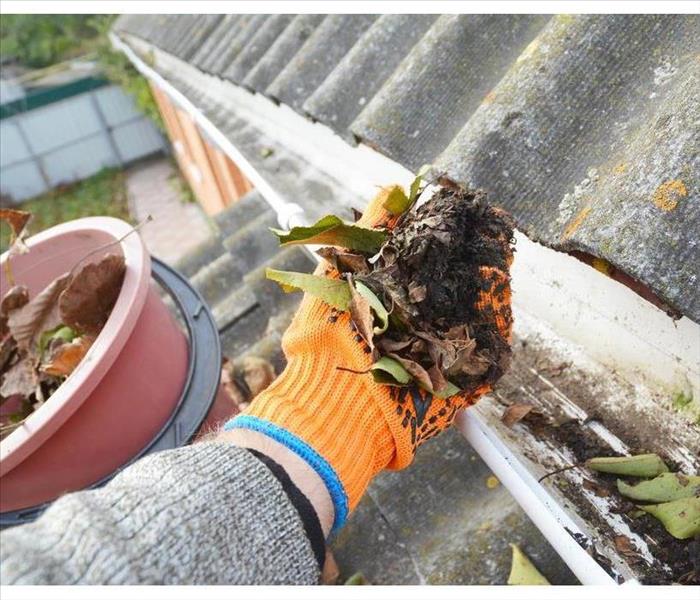 Remember to have your gutters and downspouts clean for spring weather (or spring thaw for cold areas).
Remember to have your gutters and downspouts clean for spring weather (or spring thaw for cold areas).
Prevent a Spring Thaw from Destroying Your Business
The spring brings gorgeous sunshine and beautiful flowers. However, springtime can also lead to massive flooding. Increased rains and melting snow put properties in Mariemount, OH, at risk for water damage. Fluctuating temperatures could also cause a frozen pipe to burst. While you cannot change the weather conditions, you can take steps to prevent a spring thaw from destroying your business.
1. Clear All the Snow
Any snow near your property could melt toward your building as the temperature rises. You should thus shovel the snow away from the premises. Make sure that there are no obstructions blocking the path of the thawed snow.
Melted snow on the roof could be harmful, as well. It could easily leak into your building. Safely eliminate any snow that remains on the roof. Snow and ice should also be removed from the downspouts and gutters.
2. Pay Special Attention to the Basement
If your property has a basement or crawlspace, you probably know how prone that area is to flooding. Consider installing a sump pump to remove any excess water from the property's foundation. Be sure to test and clean the pump regularly.
You should also avoid storing any valuable items in the basement. If you have to keep important company electronics or documents in that room, at least put them onto higher shelves.
3. Get Insurance
If a spring flood does occur, you do not want to spend your company's hard-earned profits on commercial restoration services. That is why you need proper insurance. While commercial property policies do not include flood coverage, you can purchase flood insurance separately.
Flooding is quite common during the spring months. The combination of melting ice and snow and heavy rainstorms could be disastrous for a commercial building. However, you can take steps to reduce your flood risk and lessen the impact of any water damage that takes place.
Plumbers Are for the Weak! You Can Replace Your Own Toilet With These 5 Simple Steps
1/19/2022 (Permalink)
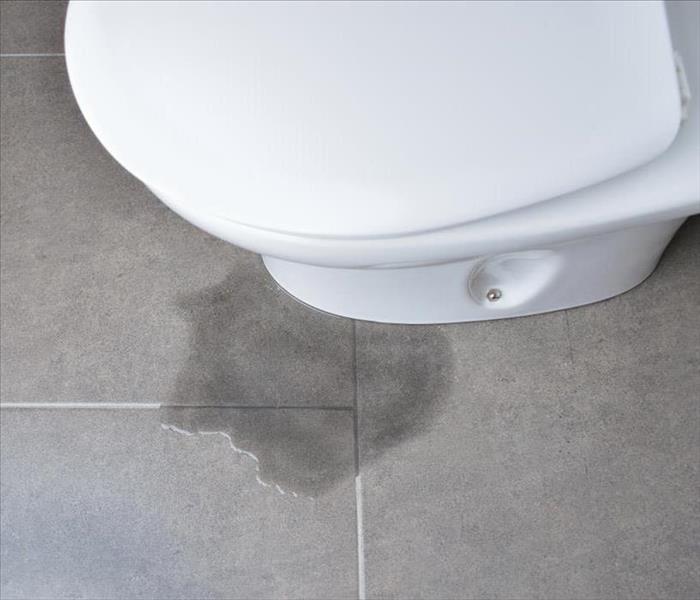 A leaking toilet can cause damage to your property.
A leaking toilet can cause damage to your property.
Five Steps To Replace a Toilet
Whether you're dealing with a leaking toilet or you simply found a toilet with crazy features at your local hardware store that you just could not live without, you may wonder how much it will cost you to have a Mariemount, OH, plumber come in to make the swap for you. Depending on your capabilities, resourcefulness and level of confidence this may be an unnecessary concern. You can replace your toilet five simple steps.
1. Sever the Water Supply
Whether you're making a toilet repair or swapping out an old toilet with a new one, you need to be sure to cut the water supply. Once the supply line is disconnected, flush and drain the tank.
2. Detach the Wax Seal
Use a wrench to loosen the bolts holding the toilet, then take a pocket knife or other sharp object and cut the caulk seal surrounding the base of the toilet. Remove the toilet gently. Use a putty knife to remove the wax seal.
3. Caulk the New Base
This step can help you prevent a future leaking toilet, as caulk serves to eliminate gaps between the wax ring and toilet base. It also helps make installation easier.
4. Install a New Wax Ring
You do not want to reuse a wax ring. Place a new one where the old was, and then lift the new toilet into place. Do not press down, as the weight of the fixture will compress the seal itself.
5. Tighten the Bolts
Once the toilet is in place, place a washer over the bolts and tighten the nuts by hand. You can use a large screwdriver or wrench to finish the job. Be careful to not overtighten, as it will crack the ceramic.
If your leaking toilet was leaking for a while, you may want to call in a Mariemount, OH, water damage restoration team to ensure there is no extensive water damage. Failure to properly clean water damage can result in costly issues in the future.
A Pipe Broke - Now What?
12/21/2021 (Permalink)
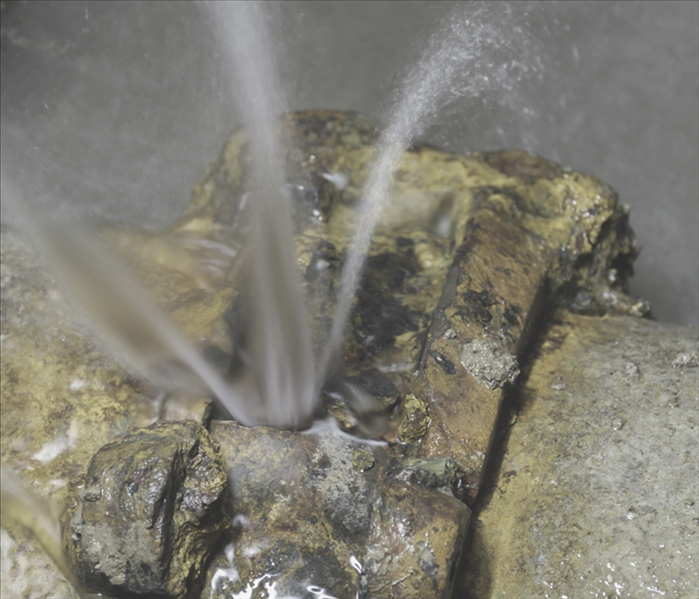 More water damages are caused by broken pipes.
More water damages are caused by broken pipes.
Protect Your Home From a Pipe Burst
If you are facing destruction or flooding related to one or more bursting pipes in your Terrace Park, OH, home, you might be feeling lost and anxious. What can you do to keep water damage to a minimum? Read on for four steps that you can take to protect your property and valuables from the burst.
1. Turn Off Water Sources
Leaving water run when there is already a moisture problem can make matters worse. Turn off all water sources at or near any affected areas as soon as possible. This helps prevent a larger flooding issue and minimizes the risk for mold growth.
2. Fix the Broken Pipe or Pipes
If you can, repair the pipe or pipes yourself or call in professional help to do so. The more time bursting pipes go without being replaced, the longer you will have moisture-related concerns to deal with.
3. Call a Remediation Service
A water damage restoration company can typically survey any existing wreckage and restore your property to the best of the team’s ability. In some cases, even broken valuables and wet papers can be salvaged. Talk to the technicians about what their restoration plan is after they have surveyed the damage.
4. Keep Records
If you have a homeowner's insurance policy on your property, keep track of all destruction and repairs that occur. Snapping photos, saving receipts and taking other actions to record the restoration process from start to finish will help you when you go to file an insurance claim in the future. Talk to your agent if you have specific questions about your coverage.
Calling Terrace Park, OH, cleanup services is your best bet when facing bursting pipes. Professionals can help minimize the risk of mold growth as well as secondary damage. Water emergencies are no joke, but taking action to protect your investments can lead to a happy ending.
How to Tell if You Must Replace My Carpet After a Flood?
11/22/2021 (Permalink)
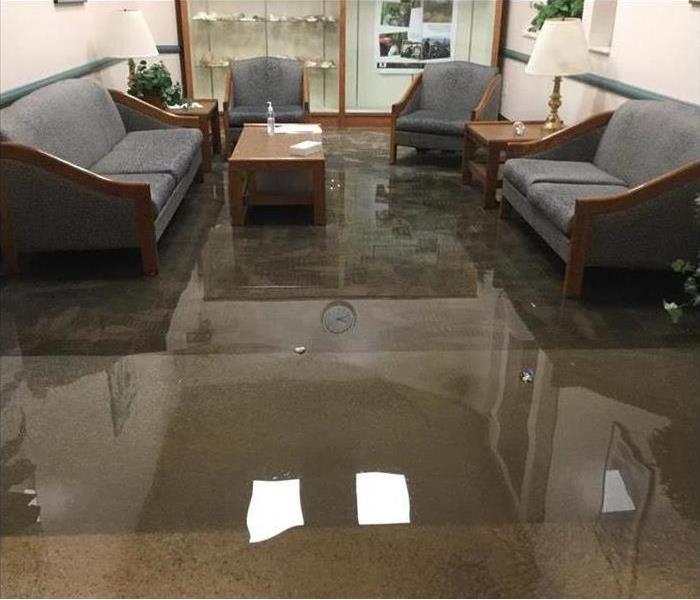 Flooded carpet in an Amberley Village, home.
Flooded carpet in an Amberley Village, home.
How Do I Know If My Carpet Needs to Be Replaced After a Flood?
Water damage can come in various levels of severity and size—from a pipe break dribbling water into a wall, to excess rain flooding an entire basement. Regardless of the issue, you may have to repair or replace parts of your home. If you’re not sure whether the floorings needs attention, pay attention to warning sides that it’s time to tear out your carpet and lay down something new.
The Solutions
If water finds its way onto your floor, you have a few options to remedy the situation. Minor issues require a quick fix, while more widespread flooding will deem a complete replacement. Here the possibilities when a pipe break or other water problems damage your flooring:
- Hand-dry the floor with towels.
- Dry the floor with towels and blow-dryer.
- Clean the carpets with professional-grade machines.
- Replace the carpets.
When to Replace: Black Water
Raw sewage flooding is perhaps the worst type of flood you can experience in your Amberley Village, OH, home. A sewer backup or major toilet leakage could send dangerous microscopic pathogens into your home. Known as black water because it contains human feces, this flood water can harm or even kill you. This will require complete restoration.
When to Replace: You Didn’t Immediately Discover the Water
If you can detect a leak or other water issues quickly, you can often salvage carpet, drywall or other parts of your home. However, if the flooding starts while you’re not at home, and water sits on the floor for days or even hours, you probably won’t be able to save the flooring. There will be too much saturation, and you should call a professional cleanup company to tear out the carpets.
There’s no reason to take chances when it comes to a pipe break and significant flooding in your house. If black water or standing water infiltrates your carpet, plan on letting a professional replace it.
Category Three Water: What Is It and Who Should Clean It?
9/27/2021 (Permalink)
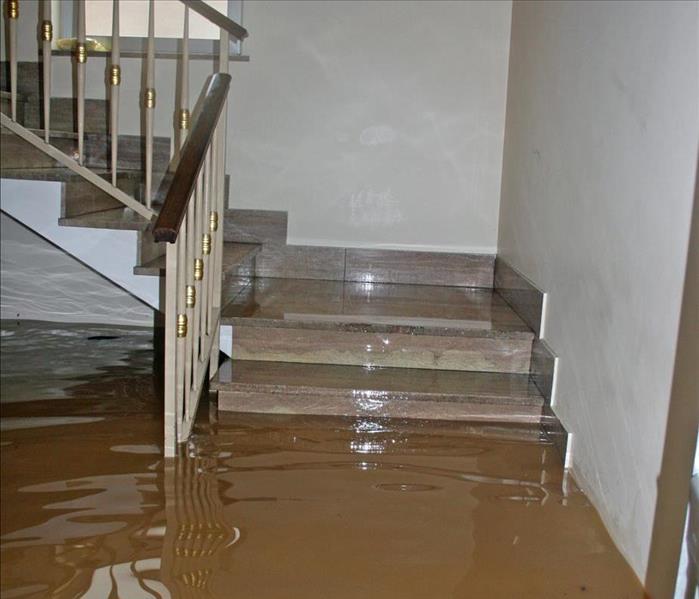 Do not let the concern over expense come above the concern for your health.
Do not let the concern over expense come above the concern for your health.
Cincinnati, OH, is prone to flooding during the rainy season. As business owners, this presents a growing concern for not only safety and profitability but the integrity of your property. Thankfully, most insurance companies cover burst pipes and toilet overflow; however, if your business is ever struck by floodwater, you may be left with a few questions about water categories, especially category three.
1. What Is Category Three Water Damage?
Category three water damage is typical in large-scale flooding. This natural disaster tends to overflow rivers and overburden sewage systems leading to a dangerous mixture call the black water. At this category level, water is capable of supporting bacterial growth and becomes hazardous for humans and pets to consume or come into contact.
2. Can You Clean Category Three Water Damage Yourself?
No, unless you are a professional, you should not attempt to clean black water yourself. This type of floodwater can cause illness and disease and possibly death if touched or ingested. It is not uncommon for this type of water to carry hepatitis pathogens, and you do not need to swallow this water to become ill or a carrier.
3. Who Cleans This Type of Water Damage?
As category three water is dangerous, it is wise to seek the assistance of professionals who hold the appropriate certifications and training to handle and dispose of this type of water. You can check with your local municipalities or emergency managers to find restoration specialists capable of this type of work.
Since flooding is a concern for most business owners in this area, and category three flood water presents a potential risk from exposure, it is wise to seek assistance from your insurance provider and local government to ensure that you as well as your business remain safe. Do not let the concern over expense come above the concern for your health.
What Not To Do When a Pipe Breaks in Your Home
3/16/2021 (Permalink)
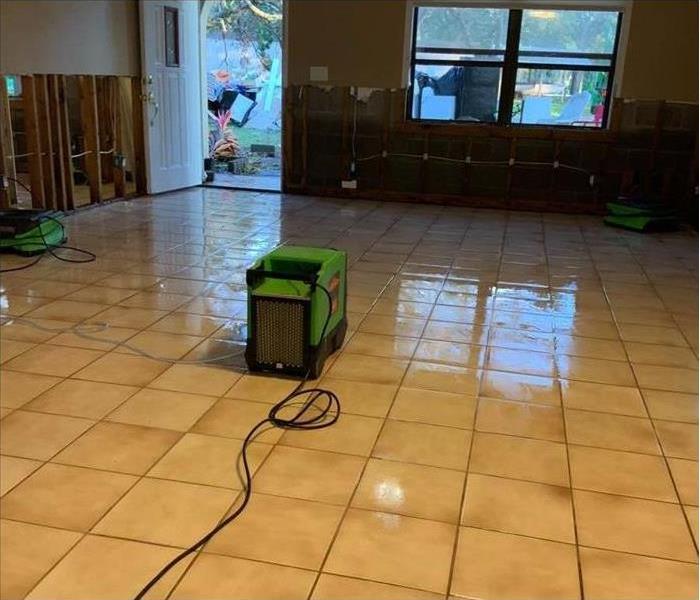 Flooded home in Mariemount, OH.
Flooded home in Mariemount, OH.
What To Do And Not Do When A Pipe Breaks In Your Home
If you have a broken pipe and it releases water into your Mariemount, OH, home, it is important to know what to do and what not to do. Some leaks may spread contaminated water in home areas, so safety is key, as is clean up afterward.
What To Avoid When a Pipe Breaks
First, always consider your safety. If you have concerns, contact a professional. Before a technician arrives, do not do any of the following:
- Never use electrical appliances if the floor is wet
- Never clean up sewage water yourself
- Never lift carpeting if it is tacked to the floor
- Never enter a room where there is structural or electrical damage
- Never use a regular vacuum cleaner to remove water
Water damage and flooding can cause severe problems for your home, so there are also actions that you should take to start to repair your property.
What To Do After a Pipe Breaks
The first step to take if you have a broken pipe is to stop the water from flowing. Turn off the water to the leaking pipe, such as by looking for the shut-off valve under a sink or by an appliance.
If you are not certain about the whereabouts of the leak’s origin, you can turn off the main water line for the house. This valve is usually somewhere on the perimeter of your home, often near the water meter. It is essential to know how to find your shutoff, so take the time to learn its location.
Next, ensure that you drain all the water from the pipes. Once completed, identify the location where the pipe burst. A plumber can repair or replace the broken pipe, while water damage restoration professionals can clean up any mess before it causes further damage.
Dealing with flooding in the home can be an ordeal. By knowing what to do during and after a pipe breaks, you can minimize the stress and damage.
3 Steps To Stop a Continuously Flushing Commercial Toilet
2/16/2021 (Permalink)
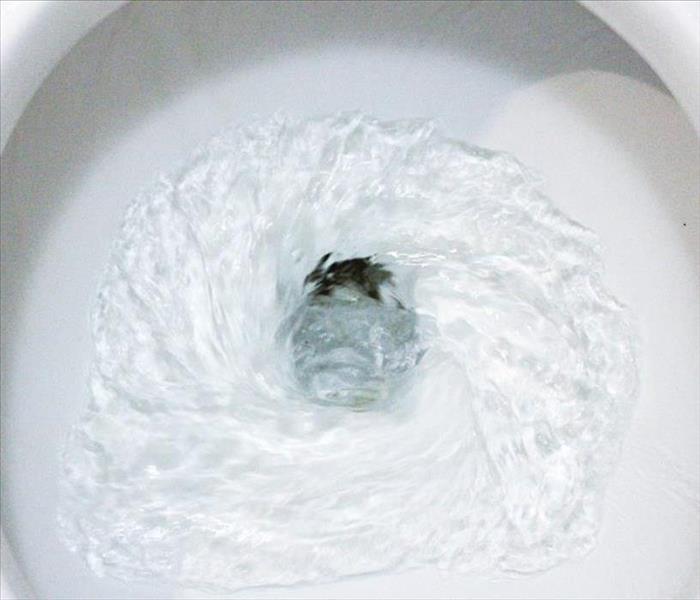 Stop a toilet from flushing.
Stop a toilet from flushing.
3 Steps To Stop a Continuously Flushing Commercial Toilet
Commercial toilets flush by using a water-diverting device called a flushometer. This device enables tankless toilets, which are optimal for high-use bathrooms. If you manage a business property in Indian Hill, OH, you probably have this type of fixture. Most of the time they operate smoothly, but sometimes they can accumulate built-up sediment that leads to a toilet overflow. When this happens, the flushometer does not stop flushing. Although flooding can be a daunting problem, there are simple steps you can take to clean out a typical manual flushometer and stop a toilet from flushing.
1. Take Apart the Flushometer
First, find the slot for a flathead screwdriver on one side of the flushometer. Turn the slot to shut off the water. Next, remove the top lid of the flushometer by loosening it with a wrench and then twisting it completely off. Placing a soft buffer material between the jaws of your wrench and the flushometer’s top lid can prevent scuffs.
Once the top lid is removed, you can unscrew and remove the flange cover. This should be done slowly and carefully, as trapped water may be released upon opening.
2. Clean the Gasket
Once the flange cover is removed, you can see the gasket. There will likely be a lot of sediment built up. This is typically the root cause of toilet overflow. Remove the gasket and clean it thoroughly, washing off all sediment. There may be a tiny opening called a weep hole. Use a small object to clear out this hole, being careful not to expand it in the process.
3. Reassemble, Test, and Restore
Reinsert the gasket, and put the flushometer back together by reversing the steps of disassembly. If the problem persists after the water is turned back on, you will need to replace the gasket. If the damage is sustained from the toilet flood, a local restoration and cleanup specialist can help get your property back in top shape.
These steps can address a toilet overflow in manual flushometers. Keep them in mind to avoid water damage in your commercial building's bathroom.
Will Filing a Claim Raise My Insurance Rates?
1/12/2021 (Permalink)
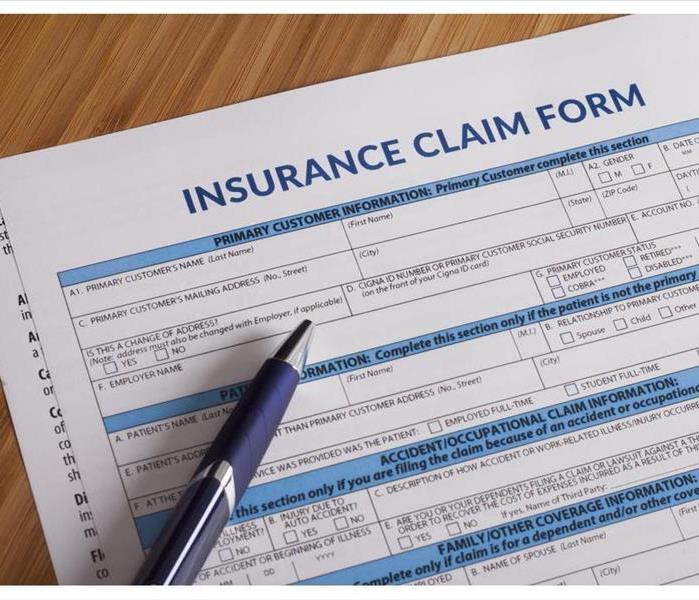 How many times have you filed an insurance claim?
How many times have you filed an insurance claim?
You come home from work to find water everywhere because one of your pipes burst while you were gone. Obviously, you're going to call a plumber or water damage specialist in Indian Hill, OH, right away, but should you also file an insurance claim? If you're concerned about making that call might cause your rates to go up, here are the factors you should consider:
The Cause of Your Water Damage and Who's at Fault
Floods — water that flows over the ground into your house — are not covered by homeowner's insurance unless you have a specific policy for it. Homeowner's will cover water damage from rain if it came through a damaged roof or window, or damage from toilets, sinks, showers, burst pipes, or lawn sprinklers, provided the cause isn't due to neglect or fault of your own.
The Size of Your Deductible
Will the cost of repairing the damage exceed your deductible? If not, is it worth filing a claim?
How Many Times You've Filed
If this is not your first insurance claim, how many times have you filed? The number of claims will most certainly impact your rates.
Your Credit Rating
Surprisingly, a low credit score can cause your insurance rates to go up, even if your home flood was out of your control.
The Type of Damage
Unfortunately, water damage is among the issues that insurance companies see as a red flag, and are therefore more likely to raise rates.
The Extent of Damage
If you are at all able to afford the repairs and restoration outright, it is best to handle things on your own. On the other hand, if the damage is catastrophic, you shouldn't think twice about making a claim.
Though dealing with water damage can be a big headache, dealing with your insurance company doesn't have to be. Understanding your policy and the factors that contribute to rate hikes before you make the call can help you make the right decision about whether to file an insurance claim.
How To Perform a Water Heater Flush
11/24/2020 (Permalink)
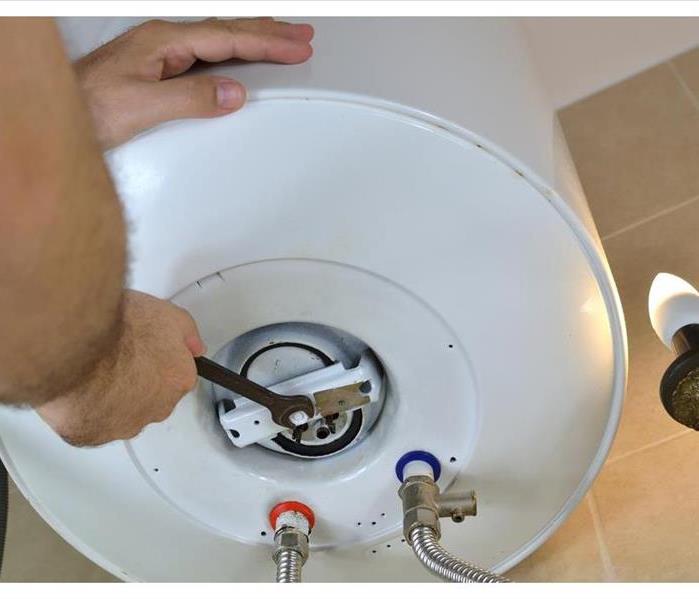 Flushing your water heater is an easy process that can be completed within moments
Flushing your water heater is an easy process that can be completed within moments
How To Perform a Water Heater Flush
A noisy water heater could be a sign of developing problems. In some cases, components need to be replaced or repaired. In others, a flush may be all that is necessary.
Heater Warning Sounds
Your device in Cincinnati, OH, could be on the verge of failure if you hear:
- Cracking, Popping or Rumbling
- Knocking
- Ticking or Tapping
- Humming
- Singing or Screaming
Installing a water softener sometimes stops these sounds by reducing the buildup of minerals and sediments. If doing this fails to silence the clatter, your system may need to be flushed, a painless process that takes approximately 20 minutes.
Heater Flushes
If your water heater uses a tank, try to perform a water heater flush every one to three years. However, the job is simple enough that you should seriously consider doing it annually.
Depending upon what type of heater you own, begin by shutting off your gas or electricity. Do the same with your cold water supply valve, usually located near the top of your heater.
Go to your sink or tub and allow the hot water to flow. Have the faucet run during your entire flush to prevent vacuums from forming while draining the tank. Open the pressure relief valve and collect the rushing water into a bucket. Doing this helps the water drain more easily.
Connect a garden hose to your spigot. Lead the other end of the hose outside, unless you want your basement to suffer water damage that requires the services of a trained residential restoration professional. Open the spigot and drain your tank until there are no more signs of sediment. Complete your flush by turning on the cold water leading into your tank. Let the water run until the liquid expelled from the other end is totally clear.
Flushing your water heater is an easy process that can be completed within moments. Before yours emits signs of trouble, make this task a regular part of your maintenance routine.
5 Tips for Preventing Water Damage During Vacation
10/12/2020 (Permalink)
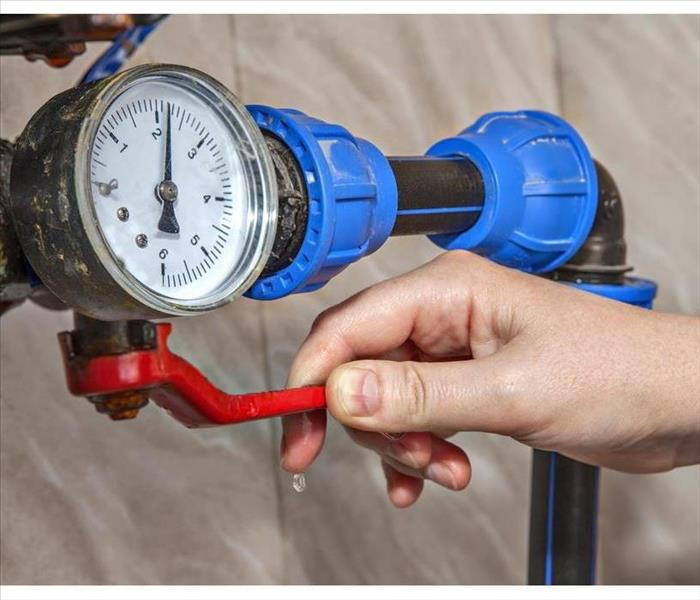 Turn the water main off to your home if no one is going to be there
Turn the water main off to your home if no one is going to be there
Five Tips For Preventing Water Damage
With a vacation coming up, the last thing you are thinking about is coming home to a flooded basement and a bill for a water pipe repair. Before you jump into your beach outfit, make sure your house is vacation-ready with these 5 tips for preventing water damage.
1. Check for Leaks
Inspect sinks, toilet tanks, and water heaters for any damage. Examine appliance hoses and basement pipes carefully for cracks and corrosion. A broken pipe that is left for a long time can lead to issues like mold.
2. Prepare the Outside of Your Home
Check your roof for missing shingles. Clean gutters and downspouts to prevent any blocking and water build-up. Small window and door leaks can become big problems, so check to make sure they are airtight. Finally, turn off outside spigots and insulate them and any other exposed piping to prevent freezing.
3. Cut Water Off at the Source
Turn the water main off to your home if no one is going to be there. Afterward, turn on all of the sinks and spigots to drain the remaining water. This is one of the best ways to avoid having to call a water pipe repair expert.
4. Leave Your HVAC System On
While you can adjust the temperature, don’t turn your ventilation system completely off. It keeps the air in your home moving and stops condensation from building up, which can cause mold in hotter months and pipes to freeze in the cold.
5. Ask Someone to Check In
It is always good to have someone you trust to stop by periodically. Leave the number of a local water damage and restoration company for them to call if there is an emergency.
With a little preparation, you won’t have to worry about the water pipe repair waiting for you in Mariemount, OH, while you are digging your toes in the sand.
What Is Category 1 Water Damage?
8/14/2020 (Permalink)
 Category 1 floods, or clean water floods, are the least dangerous of the three
Category 1 floods, or clean water floods, are the least dangerous of the three
Flooding is a problem for property owners, no matter how you look at it. That being said, there are various types of floods that each require different remediation tactics. Read on if your home or business in Terrace Park, OH, is suffering from a clean waterflood.
Types of Flood Water
There are three primary types of floodwater, each categorized by the types of contaminants present in the flood.
Category 1: Category 1 floods, or clean water floods, are the least dangerous of the three. They are categorized by an absence of contaminants. In theory, this type of floodwater is safe for human and animal consumption. Regardless, it's never a good idea to drink flood water. Category 1 water typically comes from a broken pipe or flooded supply line.
Category 2: This type of floodwater typically comes from flooded household appliances, such as dishwashers or laundry machines. While it isn't completely clean, it also isn't super dangerous either. Proper household appliance maintenance can help prevent these types of floods.
Category 3: Category 3 flood water, also known as blackwater, is the most dangerous type of floodwater. It is categorized by floodwater that has come into contact with raw sewage or human/animal feces. Due to the biohazards present, you should never attempt to remediate this type of flood without professional help.
Preventing Category 1 Flooding
Even though Category 1 floods are the least problematic of the three, they still need to be taken seriously. If left unchecked, any type of flooding can result in water damage or mold growth. You can help prevent these floods by routinely monitoring your supply line for damage and fixing leaky pipes as soon as you discover them.
Clean water floods are often indicative of bigger issues in your home or building. Flooded supply lines or broken pipes within the walls and ceilings can cause subsequent issues if left unchecked. If you believe that your home or business is at risk, you should contact flood remediation experts as soon as you can.
Will a Wet Crawl Space Cause Water Damage?
5/20/2020 (Permalink)
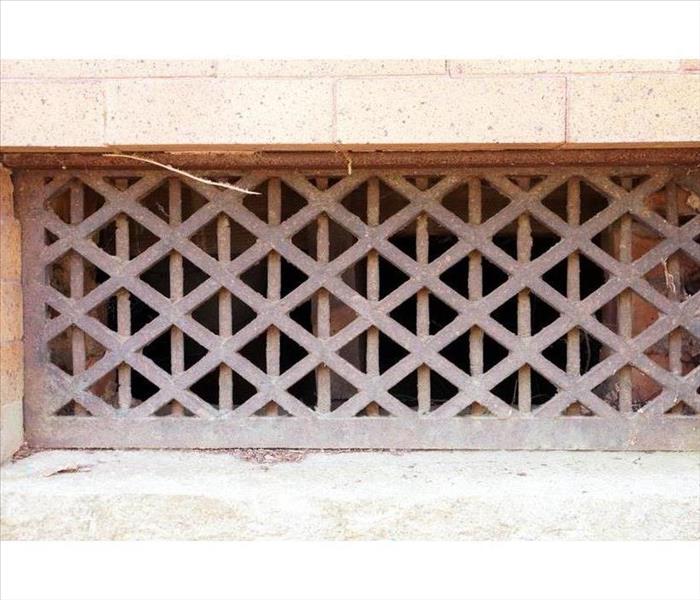 If you have a wet crawl space in your Terrace Park, OH home you should call an expert to inspect
If you have a wet crawl space in your Terrace Park, OH home you should call an expert to inspect
If you have spotted water in your home's crawl space, you may worry that it will cause water damage to the living area. While a wet crawl space shouldn't necessarily cause alarm, it can sometimes cause a flood. Knowing what caused the water will help you determine the best course of action.
What Can Cause Crawl Space Water?
Cracks that develop in the floor, walls, or joints
Condensation or sweating of the walls
Burst or leaky pipe
Flooding of surface water
Gutter and downspout issues
When Should You Worry About a Wet Crawl Space?
The first important step is to determine whether or not there is standing water in the space. If you see a pooling of water, this could indicate a serious problem. Call a water damage restoration service right away to inspect the entire area. A professional will be able to determine the source of the water.
If there is no standing water, an excessive amount of moisture could still cause problems later on.
Inspect the walls and pipes of the crawl space for moisture. Wet walls or pipes can indicate a leak somewhere, which should be inspected as soon as possible by a professional.
Check the gutters and downspouts on the outside of the home. If you find any broken or faulty drainage tubing, have it replaced.
Check any wood in the crawl space to see if it is wet or covered with fuzz. This indicates that mold is present.
If you smell an odd or unpleasant odor, you likely have mold.
Whenever mold is suspected, you must call a professional as soon as possible. He or she will be able to pinpoint the cause and help to remediate the mold problem safely and effectively.
If you are worried about your home's wet crawl space in Terrace Park, OH, your best strategy is to have an expert inspect it right away.
How Can I Stop My Toilet From Overflowing?
5/6/2020 (Permalink)
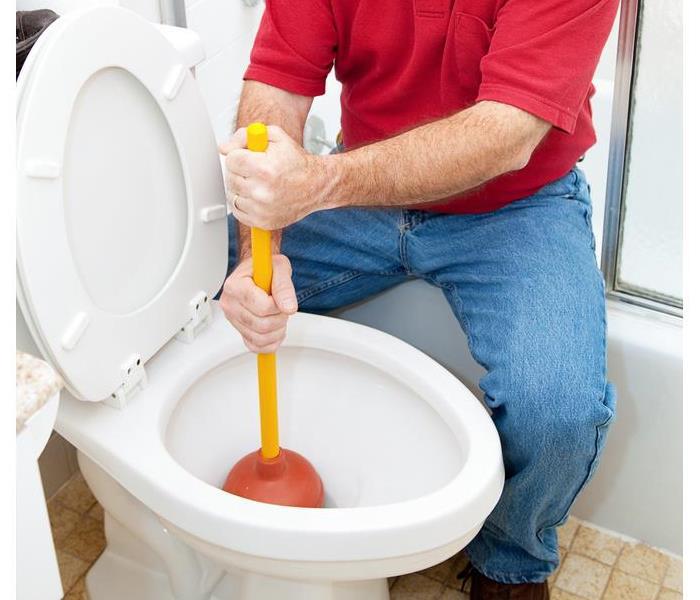 Use a toilet plunger to try to break up clogs that may be in the drain
Use a toilet plunger to try to break up clogs that may be in the drain
How Can I Stop My Toilet From Overflowing?
A clogged toilet is a nuisance, to say the least. You have other issues to deal with as a business owner. It’s generally a DIY job, but could easily develop into a toilet overflow if it’s a sewage system blockage. What then? Take these steps to stop it:
1. Shut Off the Water Supply
First, make sure that the main water supply line to the building is turned off. This will prevent more water from coming in.
2. Remove the Tank Lid
Next, you’ll need to access the inside of the toilet tank. Remove the tank lid and carefully set it aside.
3. Adjust the Flapper
The rubber flapper is at the bottom of the tank. Press down on the flapper valve to secure it. This will prevent more water from entering the bowl and reduce the chance of overflow.
4. Lift the Float
Next, you’ll need to stop water from filling the tank. Raise the tank fill valve float ball. Even if it’s a clogged toilet, the water in the bowl should start decreasing. When it’s back to a normal level, release the float. Watch to make sure that it doesn’t overfill.
5. Shut Off the Toilet Supply Valve
If the water level is still too high, lift up on the float again. Hold it up as you shut off the water supply at the toilet valve. This valve should be located beside or behind the toilet; turn it to the right to shut it off.
6. Use a Plunger
Use a toilet plunger to try to break up clogs that may be in the drain. Try plunging several times. Hopefully, the clog contents will come back into the toilet bowl instead of further down the line.
If only one toilet has issues, it’s probably just a clog in that toilet. However, if you find that multiple toilets have problems there’s probably a sewage system blockage. If you have damage from a toilet overflow as a result of a clogged toilet, you can count on water damage restoration experts to restore your Deer Park, OH, building to its preloss condition.
How to Find Hidden Leaks in Your Bathroom Before It’s Too Late
2/17/2020 (Permalink)
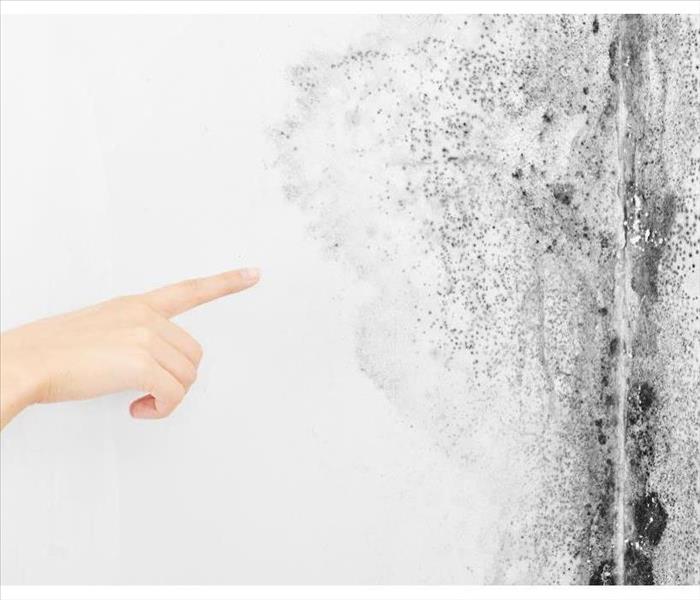 The first sign of a hidden leak is usually mold and mildew on the outside of a wall
The first sign of a hidden leak is usually mold and mildew on the outside of a wall
Common Causes of Bathroom Leaks
Nothing is more annoying than the sound of dripping water at night. It can keep you up, but it will also let you know there’s a breach somewhere. A bathtub leak can happen in the muffled darkness of the floor, and you’ll never know until it’s too late. As it turns out, these quiet drips can cause extensive water damage with time, especially in vinyl-covered wooden floors.
Common causes of bathroom leaks in Madeira, OH include:
- Grout deterioration
- Broken faucet
- Damaged drain
Mild Dew or Mold
The first sign of a hidden leak is usually mold and mildew on the outside of the tub. While it might not be a sure sign of a spill, it does indicate that something is off. To be sure, dry any water that might be on the outside surface of the tub, then stick newspapers on it. Fill the washbasin with water and check for any wet patches. That should point you straight to the bathtub leak if there’s one.
Damaged Walls or Ceiling
Everyone splashes water on the bathroom floor now and then, and that should not be a problem. These decks are built to take occasional water exposure. However, if you see a “coffee patch” or crack on the ceiling below the washroom, there’s an issue. You are probably dealing with a shower pan leak or broken drain line.
Earthy Smell
Mold has a distinctive earthy smell that could cause health complications in children, elderly individuals and people with respiratory afflictions. It is a clear indication of hidden leaks in the house, which happen to be notoriously hard to track down. Water can drip at one point and move to damage another part of the house, leading to a misdiagnosis.
With these tips in mind, there’s no way a bathtub leak can catch you by surprise. The general idea is to be suspicious of anything that looks off, regardless of how insignificant it may seem.
Restoration of Category 3 Water Damage
1/27/2020 (Permalink)
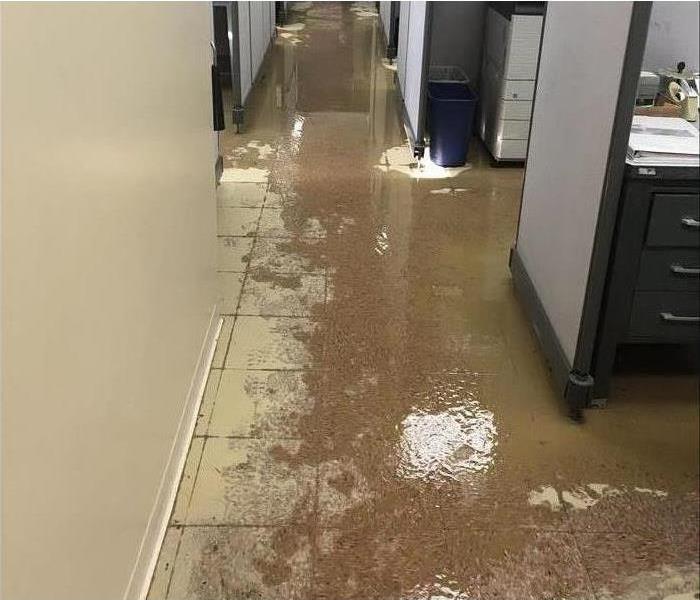 Office flooding in Amberly Village, OH
Office flooding in Amberly Village, OH
Water leakage in commercial buildings can pose serious health risks to employees. When floodwater seeps into the carpet, toxic mold can grow if it isn’t handled properly and quickly. Water can also contain harmful substances like pathogens, bacteria and other toxins. Pesticides, heavy metals, and raw sewage can also be found in the water. In addition to severe illness that can be caused by these toxic substances, an untrained person could slip and fall, injuring themselves. There is also the risk of electrical equipment being exposed to the water, which could prove fatal.
Examples of Category 3 Water Damage:
• Sewage
• Flooding from seawater and other types of floodwater
• Ground surface water and water rising from streams or rivers
• Water caused by hurricanes, heavy rains and other weather incidents
• Toilet overflow that comes from beyond the toilet trap
Water Damage Repair Quick and professional cleanup is critical in handling water damage. Cleaning up Category 3 water damage must be handled by experts who are trained in handling these situations. If you live in Amberly Village, OH, the sooner the professionals can begin the restoration process, the better the chances of completely repairing and restoring the area.
The first step will be to analyze the situation to better understand how much damage has occurred. The trained professionals have equipment to detect any moisture hidden below the surface. Once all the water has been extracted, moisture levels can be monitored to ensure that the area is dry. Fans and humidifiers can facilitate this process as well. After all, areas are dry, the facility will be sanitized and deodorized to remove any unpleasant odors. To slow the growth of unwanted bacteria, biocides can be applied as well.
Damage caused by floodwater and other water events is a serious matter, but if handled by professionals you can have your business up and running successfully again.
How To Know If You Have a Shower Leak
12/10/2019 (Permalink)
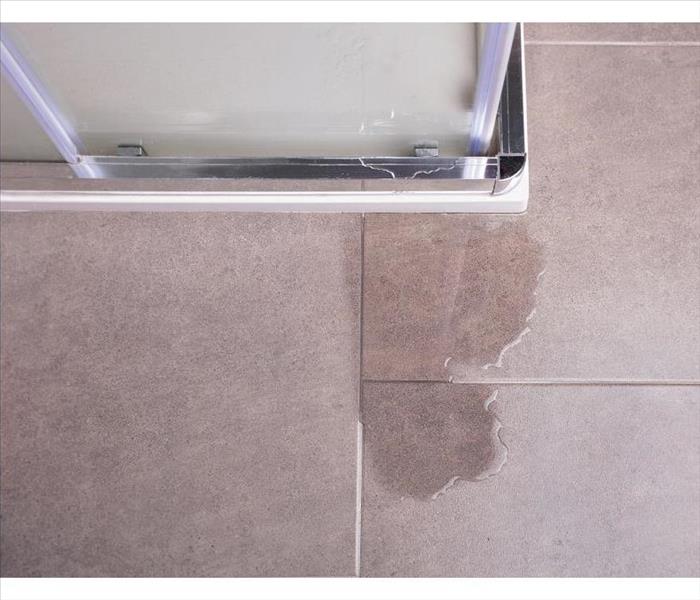 Shower leak in an Indian Hill, OH home
Shower leak in an Indian Hill, OH home
Locating Bathroom Leaks in Your Home
A shower or bathtub leak can be hard to find. After all, your tub is going to be already wet after you use it. It thus may be difficult to determine whether the moisture in your bathroom is normal or the sign of a larger problem.
Still, there are ways to find evidence of a leak in your home. For starters, you can look for damage to other areas besides the bathroom, including:
- Carpeting
- Floor tiles
- Crawlspaces
Water in any of these locations could be a sign of a problem with your shower. Read on for more tips on locating bathroom leaks in your home.
Keep Your Eyes Open
A leak in the shower pan often causes a buildup of water in the crawlspace. Go into this room and look for crusty stalactites and wet, black wood.
Stains to wood trim and baseboards near the bathroom are also evidence of a possible shower pan leak. Other warning signs to look out for include loose floor tiles or carpet. In particular, a shower or bathtub leak can cause the tack strips to rust.
Check for Cracks
You should inspect the bathroom for signs of leaks, as well. Since cracks can be the source of a leak, check the corners to see if the grout has gotten loose and washed away.
The tiles of shower walls can also break or crack over time. Have a plumber fix the issue immediately before it becomes a major problem.
Inspect the Shower Pan
The shower pan is another common source of leaks. You should inspect it regularly to check for problems. The threshold, in particular, is susceptible to breaking down.
Once you have found the source of your shower or bathtub leak, you need to repair the issue before it destroys parts of your Indian Hill, OH, home. If any floors or walls are harmed, your local water damage repair specialists may be able to help.
4 Problems That Can Cause a Toilet Leak
10/16/2019 (Permalink)
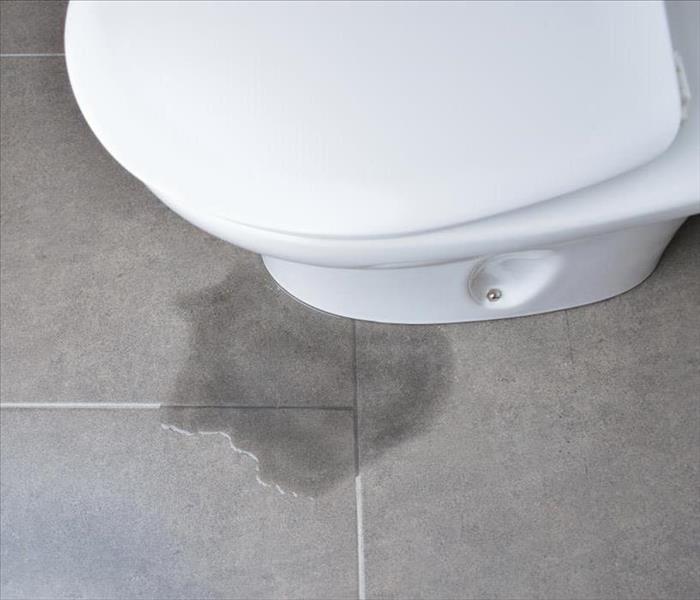 A leaking toilet is often an easy fix, but you want to make sure to fix it quickly
A leaking toilet is often an easy fix, but you want to make sure to fix it quickly
4 Problems That Can Cause a Toilet Leak
The toilet in your bathroom is a relatively simple apparatus, but multiple things can still go wrong that cause it to leak water onto your floor. There are four things that plumbers look for to determine the reason behind your leaking toilet.
1. Loose Bolts
Pooling water at the base of the toilet can mean several things. The easiest thing to fix is a loose bolt. Before you call for a plumber in Madeira, OH, try tightening the bolts around the base. If this stops your bathroom leak, that is likely the only thing that was wrong.
2. Faulty Gasket
The wax gasket is the seal that holds the toilet in place. It also keeps water from escaping and damaging your floor. To replace a dry or broken gasket, you have to remove the toilet and scrape the old gasket off the floor. Once you've determined the flange is intact, you can replace the gasket and return the toilet to its position. Most homeowners have the tools to do this themselves, but a plumber can help if you are not comfortable with the task.
3. Broken Valve
If the shutoff valve is broken or malfunctioning, it will probably result in a leaking toilet. Water damage specialists often have to replace walls and flooring when a faulty valve releases a lot of water in a short amount of time. Plumbers can inspect and replace bad valves so that your toilet runs efficiently.
4. Cracked Bowl
If the toilet bowl itself is cracked, water is likely to leak out of it. If you cannot see the crack, it can be difficult to determine the source of the problem. Inspect your tank thoroughly to look for this possibility.
A leaking toilet is often an easy fix, but you want to make sure to fix it quickly. Finding the source of the leak is the first step in doing so.
Insurance Claims: How to Prepare for an Adjuster's Visit
10/8/2019 (Permalink)
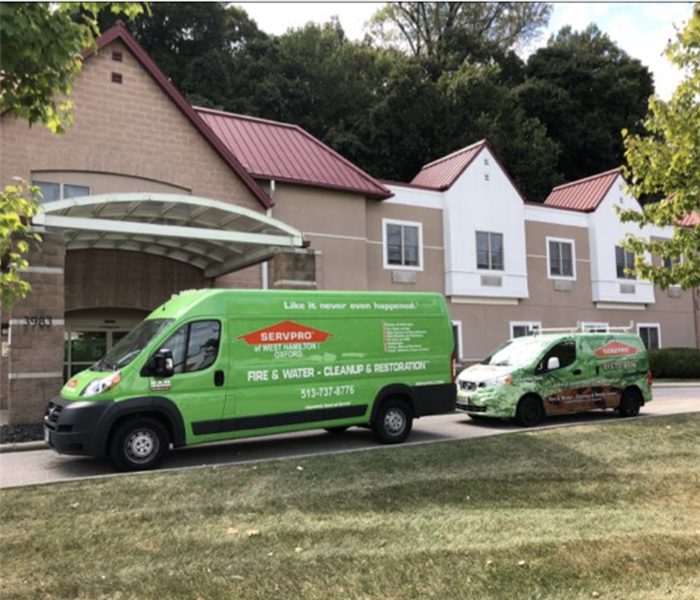 While it is part of the claims process, a home adjuster visit can feel oddly intrusive and even judgmental, but they don’t have to.
While it is part of the claims process, a home adjuster visit can feel oddly intrusive and even judgmental, but they don’t have to.
While it is part of the claims process, a home adjuster visit can feel oddly intrusive and even judgmental, but they don’t have to. When viewed as only a process, a visit from an adjuster can be systematic and judgment-free, especially when you plan and prepare for their visit with the four steps below.
1. Prepare a Loss Inventory
Any insurance claim will likely require a loss inventory, which is an itemized record of any of your belongings too damaged to repair or restore. In addition to cataloging the information, it is a good idea to photograph any losses to show the adjuster as proof of loss.
2. Identify Structural Damage
Locate any structural damage before the home adjuster visit to ensure efficiency. You will want to look for cracks in walls or foundational separation. Additionally, you can check for sagging of the roofline or weeping/sweating around basement walls. Any structural concerns should be discussed with the adjuster to ensure they have the complete picture.
3. Collect Contractor Bids
Before the adjuster’s visit, you can begin the process of collecting cleanup and restoration bids. Professionals in the Cincinnati, OH, area will likely be better suited to your specific needs because they will be more familiar with local building codes. Receiving bids from a minimum of three contractors is standard and maybe expected by your insurer.
4. Make Copies of Important Documents
As adjusters are busy, typically having more than one client and claim at a time, it is beneficial for you to maintain copies of any relevant documents and correspondence between you and your insurer to substantiate your claims. The adjuster will likely have all this information, but in the off chance that there is a discrepancy, it is better to have proof and validation.
While it may be easy to see a home adjuster as the enemy, someone who is trying to cheat you out of your hard-earned dollars, the truth is that adjusters want to make sure you get what you’ve earned. You can help make that happen by following the steps above, making the process as efficient as possible.
How To Prevent Plumbing Issues in Your Commercial Building
10/7/2019 (Permalink)
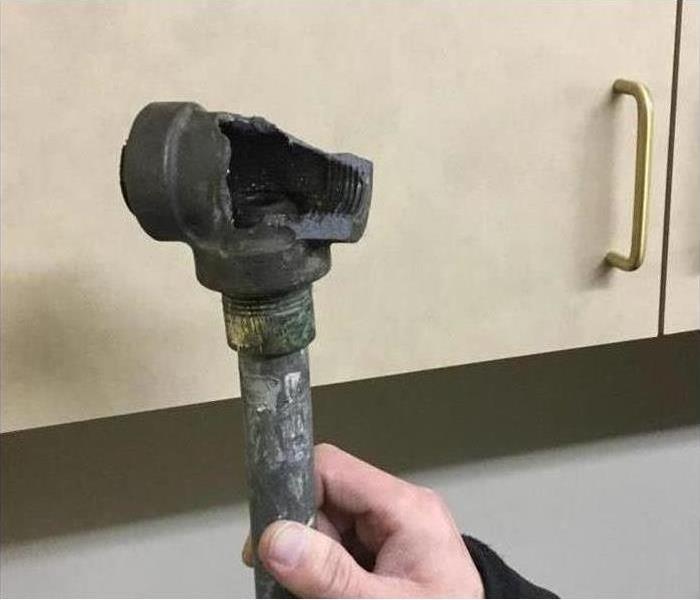 Plumbing problems are common in commercial buildings.
Plumbing problems are common in commercial buildings.
Plumbing problems are common in commercial buildings. With so many customers and employees going in and out, bathrooms and sinks are used repeatedly. Frequent use of plumbing systems can lead to problems such as the following:
- Clogs
- Broken fixtures
- Leaks
A broken pipe or damaged water main can lead to huge amounts of water leakage. If you are currently dealing with water damage, call a professional to help you start the restoration process. If you’d like to avoid serious issues from happening easily in your commercial building, here are a few proactive tips that can keep your building safe from water damage.
Keep an Eye Out for Clogs
Unless you’re talking about the wooden footwear, clogs are annoying. They can be even more irritating when they occur in your building’s bathrooms. Employees and customers alike lose access to toilets, sinks, and showers. While this can lead to bad business or conflict within the company, clogs can lead to more serious issues. Water pressure can rise to dangerous levels when the plumbing system is blocked.
One way to avoid clogs is to clean the bathrooms regularly. This can help remove potential obstructions. Another great way to avoid clogs is to put up signs that remind customers and employees what they can flush down the toilet. However, if clogs are still recurrent it might be a bigger problem within the pipes themselves.
Check Your Water Temperature
Depending on the business, you might count on the temperature of your water to always accurate. Either way, it’s always a good idea to check your water heater when temperatures start fluctuating or if you are struggling to get hot water. This often means that your water heater is broken or leaking.
To avoid water damage and other serious issues, don’t ignore the signs. You can also check on your water heater regularly to help you identify any possible difficulties. Check the outside of the heater for any external damage and then flush out the tank. You can also check the anode rod and heater vent for any problems.
You can prevent many plumbing problems from affecting your business in Hamilton, OH, if you take careful precautions. Look for any indications and act quickly to avoid dealing with damage.
Preventing Water Damage in Your Home
8/21/2019 (Permalink)
 Water leak in a Madeira,OH property
Water leak in a Madeira,OH property
How To Prevent Water Damage In Your Home
One of the most destructive forces in nature is water, and when it enters your Madeira, OH home, the damage can be devastating and costly. In addition to damage caused by the water itself, mold can easily form and ruin the integrity of your walls, flooring, and even the support beams. Understanding the many ways that you can find water in home, and how to prevent it from happening, are the best ways to stop water damage before it starts.
Sources of Water Leaks
You may wake up one day and find water in home stemming from one of several sources, including:
- Structural leak: The roof, windows, doors, and other areas susceptible to cracking or normal wear and tear can leave the home vulnerable to water leaks
- Broken pipe: A number of water pipes run throughout the home, and any one of these can crack or burst at any time during extreme cold weather, or simple wear and tear over time
- Appliance leak: Toilets, washing machines, dish washers, and other household appliances can malfunction and allow water in home
Preventative Measures
While it is difficult to safeguard against every possible water source, there are steps that can be taken to minimize the chance that your home will suffer from water damage. Bad weather is likely the most destructive source of water leaks, so ensuring your roof, windows, and the overall structural integrity of your home is free of cracks. Should a leak form, repair the area quickly before a more destructive storm can make the area worse. Additionally, a broken pipe or break in a major appliance can leave huge puddles when left unchecked. Proper pipe cleanup and repair, as well as regular inspection on pipe integrity, will help keep your home safe. Finally, proper drainage in and around your home will prevent water from building up against your home and its foundation, which will in turn extend the life of your home’s structure. By regularly maintaining the integrity of your home, you can help prevent water damage before it starts.
Water Categorization: Category Two
4/18/2019 (Permalink)
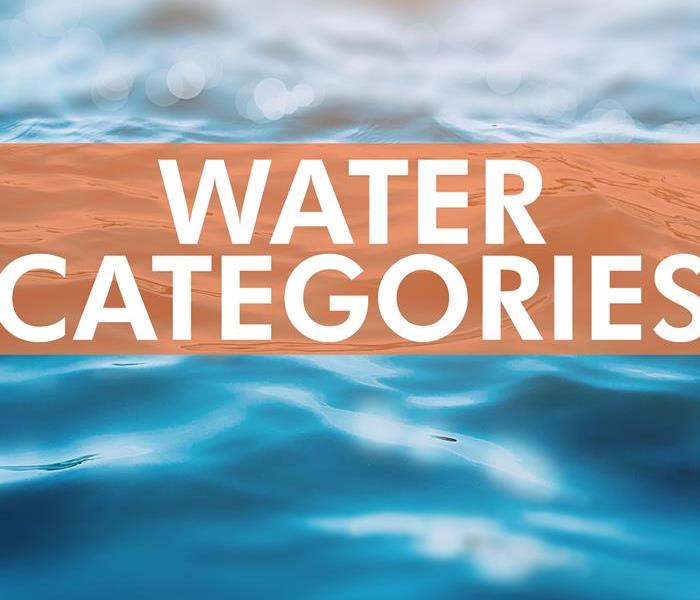 Floodwater has three categories and four classifications, and the hazardousness of the water increases with each ascending scale.
Floodwater has three categories and four classifications, and the hazardousness of the water increases with each ascending scale.
Floodwater has three categories and four classifications, and the hazardousness of the water increases with each ascending scale. Therefore, category one, class one is the least concern in terms of water damage, with category four, class four being the most concerning. Category two falls in the middle of the spectrum, and there are many likely causes, like a failed water pipe repair, that may have led to its development.
1. Category Two
Category two likely started from a sanitary broken pipe, meaning that it originated as clean water and then became contaminated over time. While this type of water started from a clean source, it would now be considered grey water, and it should not be consumed at this point.
2. Standing Water
While a water pipe repair may have fixed the initial issue, the water that was left standing after the break has had time to absorb chemicals and bacteria. The waiting and absorption can cause an escalation in classification and category because the water becomes contaminated and unsafe.
3. Soaking Through
As stated previously, waiting too long after an area has flooded from a sanitary source allows for absorption and an increased categorization. However, this transformation also occurs when the clean water soaks through from a higher level to a lower one. The water passes through building materials and collects contaminants along the way, meaning that the water can be category one on an upper level but category two on a lower level.
4. Proper Handling
A plumbing specialist in the Cincinnati, OH area should be called in to handle the removal and cleanup of category two water damage because of the health risks. Gray water is not safe to consume or touch, and it should be dealt with rapidly to avoid further deterioration and contamination.
There are several tiers to water categorization, and while a water pipe repair may stop the flooding from a clean source, the standing water can quickly transform into category two or worse. Therefore, when a pipe breaks or your building experiences flooding, call in a professional.
Three Things to Avoid After Experiencing Water Damage to Your Home
3/18/2019 (Permalink)
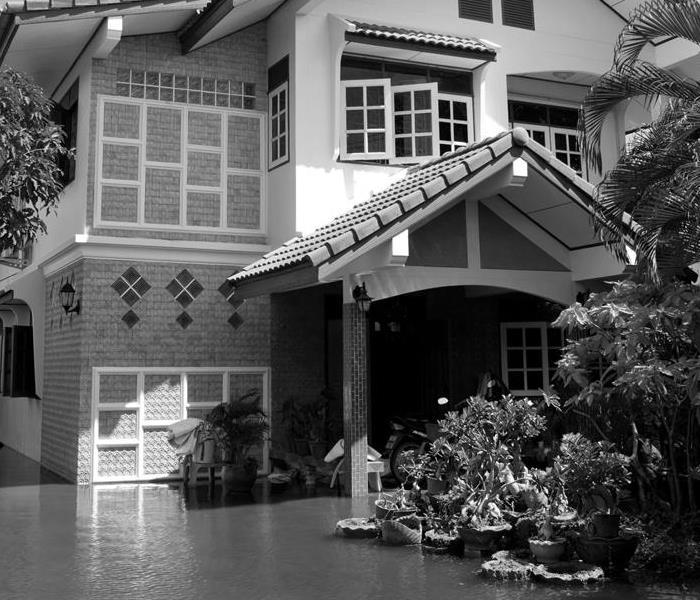 Once you have reported the damage to your agent, they may recommend a water damage remediation service to take care of the damage.
Once you have reported the damage to your agent, they may recommend a water damage remediation service to take care of the damage.
Three Things To Avoid After Experiencing Water Damage To Your Home
If a storm or broken pipe has caused water damage in your Terrace Park, OH home, you may be at a loss for what to do next. While it may be stressful, you don’t need to panic. There are services that can help you deal with the situation. Aside from panic, here are a few other things you should avoid in the event of water damage.
1. Waiting to Call Your Insurance Agent
One of the first things that you should do in any home emergency is to call your insurance agent. In order to get the most from an insurance claim, you should avoid waiting too long to report the flooding or other damage. It is best to get the process started as quickly as possible, so you should make the call as soon as you are in a safe place, if the damage is severe enough to require relocation.
2. Letting the Water Sit
While you may not be able to take care of the damage completely, if water in the home is left alone, the damage will continue to worsen and may cause walls or floors to become warped. It can also make it easier for a mold growth to develop. There are some things, such as blocking off other areas of the house or placing tarps on damaged windows, that you can do as a temporary measure to keep water from spreading.
3. Attempt to Make Repairs Alone
Once you have reported the damage to your agent, they may recommend a water damage remediation service to take care of the damage. They can further remediate your home to prevent damage while they make repairs to the broken pipe or other sources of water. They can also help to save any of your belongings that are not beyond repair.
If you have water damage from a broken pipe or other problem, keep this advice in mind. It will allow you to take the necessary steps to reduce home damage and get the most from your insurance claim.
Ice Dam: What It Is and How To Prevent It
12/29/2018 (Permalink)
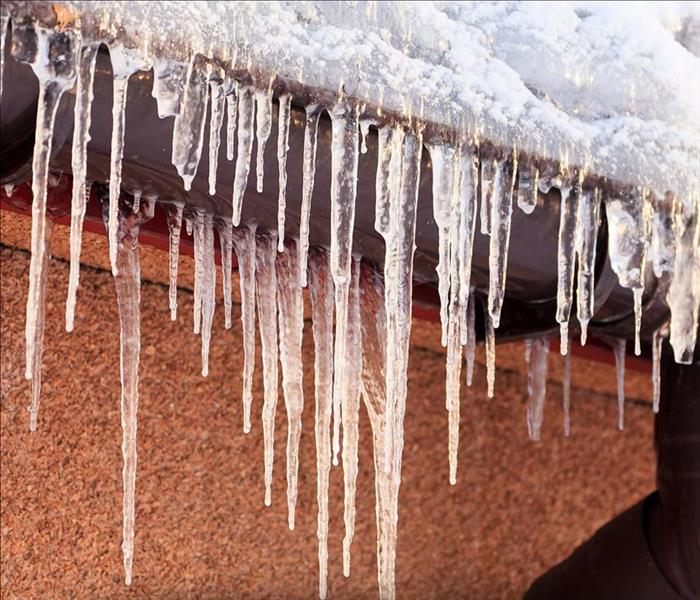 Ice dam in a Cincinnati, OH
Ice dam in a Cincinnati, OH
An ice dam is a long rim of ice that forms along the edge of your roof and hinders the runoff of melting snow. These wintery monstrosities can cause a significant amount of damage and should be dealt with as quickly as possible. However, before you resolve the issue, it is necessary to understand the problem entirely.
Root Cause
The long bands of ice that form along the eaves of your roof are caused when melting snow is unable to flow off the roof before refreezing. This occurs because of heat loss and the fluctuating temperature along your roof. The peak of the roof is the warmest area because it sits directly above the living space. The edge of your roof is the coldest, usually the temperature of the outside, because it overhangs the structure of your home. This means the snow melts at the peak and then refreezes when it reaches the edge of the roof, causing ice bands to form.
Potential Damage
An ice dam can cause significant damage. From a roof leak and water damage to wet insulation and mold, dams can wreak havoc in the winter months. It is crucial to find the underlying cause of ice buildup on your roof to ensure that financial expenses are minimized.
Possible Solutions
There are a variety of solutions for ice buildup on your roof:
- Increased insulation
- Improved ventilation
- Reduced air leakage
The first thing to do before trying any possible solution is to have your roof inspected, ensuring the right solution is used. You can reach out to an emergency restoration company in the Cincinnati, OH, area for a quick inspection and recommended solutions.
An ice dam is beautiful, but so is a poison frog - and you don’t want any of those hanging around your property. Ice presents considerable risks to your home if left alone, so be sure to handle dams quickly, calling in assistance if needed.
Restoring Your Cincinnati Commercial Property After A Water Damage Event
9/22/2018 (Permalink)
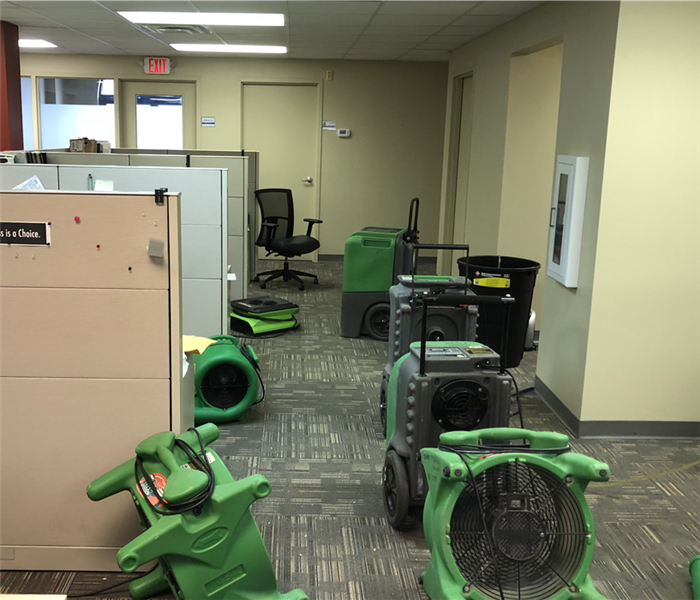 Drying a large commercial building after a pipe burst and flood.
Drying a large commercial building after a pipe burst and flood.
Flooding and water damage events at Cincinnati commercial properties are often complex with numerous issues that require a knowledgeable and flexible response. Whether we’re dealing with a relatively small water cleanup scenario or a large scale event, we work quickly to assess each unique situation and isolate the damaged area. In many instances, normal operations can continue in a temporary space while we restore your facility.
Restoring Commercial Properties Presents Unique Challenges
Our professionals are trained to be mindful of legal and environmental concerns and strive to fully restore the damaged area while working within your budgetary constraints. We understand that every hour spent cleaning up is an hour of lost revenue and productivity. So when an emergency situation arises in your business, give us a call and we’ll be there fast with the help you need.
About SERVPRO of SERVPRO of East Central Cincinnati
SERVPRO of East Central Cincinnati specializes in the cleanup and restoration of commercial and residential property after a water damage event. Our staff is highly trained in property damage restoration. From initial and ongoing training at SERVPRO’s corporate training facility to regular IICRC-industry certification, rest assured our staff is equipped with the knowledge to restore your property.
Wood Flooring Care During a Water Damage
9/21/2018 (Permalink)
 Keep your wood floors dry and only wet clean them every 2 months.
Keep your wood floors dry and only wet clean them every 2 months.
Wood floors require extra care, but that doesn't mean you should mop yours every week. Wet-clean no more than 1-2 months to maximize your floor's longevity.
After a water damage this is especially true and may require resurfacing your floor to return it to its previous condition. A trained water restoration technician with the proper equipment can restore most quality hardwood floors to its natural moisture content in a timely manner limiting the need to replace the affected flooring. Every situation has its own set of unique challenges and knowing the best tool for the job is what we at SERVPRO consider a welcomed task.
Some flooring is manufactured using man made and natural materials these types of floors are often considered non-salvageable. Which means that it will not return to it's previous condition. SERVPRO of Central East Cincinnati 513-561-7378??.
Frozen Pipes in Greater Cincinnati Ohio
12/27/2017 (Permalink)
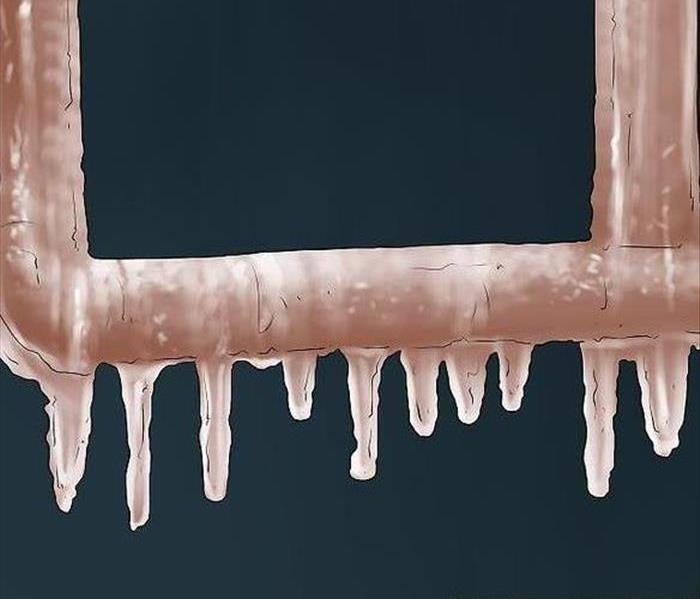 Frozen Water Spigot
Frozen Water Spigot
It is the time of year when we need to be on the lookout for frozen water pipes. All residential and commercial properties with running water are at a risk for this type of problem. Facing sub zero temperatures can often pose many types of problems. One that we see all too often is the frozen pipe. Now many times this can be prevented with a little bit of forethought and preparation. Let the cold water drip from an open faucet can help prevent a full on freeze. A second option is to add heat to your pipes and or the area the plumbing runs through. This is not always a realistic option for all situations. Both options have a negative impact on the environment by using resources however the cost often out weighs the damages caused by a frozen water line. If the cold weather strikes your property call SERVPRO at 513-561-7378






 24/7 Emergency Service
24/7 Emergency Service





























